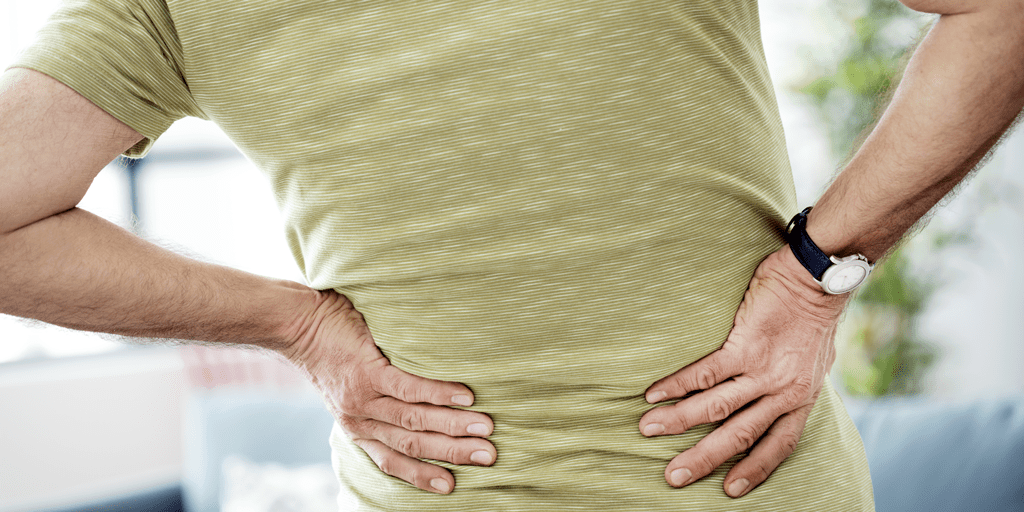
Lower back pain is classified as pain within the lower two quadrants of the back, typically starting from the twelfth rib, down to the pelvis. It can also include the back of the hip – or sacral area. For this reason, sacroiliac pain and back pain are often grouped together.
How Common is Lower Back Pain?
It’s estimated up to 80% of people will experience back pain in their life. Globally, and at any point in time, 18% of the population has back pain. Over a one-month period, that number is 31%. Lower back pain is found to be more common in women. (Lin et al. 2013)
This chronic health problem forces more people out of the workforce than heart disease, diabetes, hypertension, neoplasm, respiratory disease, and asthma combined. It is also the leading cause of years lived with a disability and the sixth highest cause of global overall disease burden. (Meyer et al. 2017; Schofield et al. 2015)
Lower back pain often requires older workers to retire prematurely. As a result, people with back pain retiring earlier have 87% less total wealth than those who are employed full-time.
What Contributes to Lower Back Pain?
While lower back pain is common, there is no conclusive data as to what causes it. 80 – 90% of low-back pain is non-specific, meaning clinical diagnostic tests don’t reliably tell why we experience most types of pain.
Researchers speculate that contributing factors include sedentary lifestyles, carrying more weight on our trunk than needed, and not being able to engage stabilizing muscles in the correct way.
Movement & Lower Back Pain
Every movement we make requires stabilization in the back, which is why lower back pain can be so profoundly disabling. When you experience back pain, your first instinct might be to rest and resist moving. However, moving around might help more when it comes to easing back pain.
In fact, research has shown that back pain wasn’t as disabling until the introduction of Western Medicine. Historically, Western Medicine relied on diagnostic imaging to determine structural pathology and recommended bed rest and medication for treatment. Studies further suggest that reducing activity without a corresponding reduction in pain can then promote a fear of movement making the pain even more difficult to treat. (Krestiansen et al. 2014; Bergbom et al. 2011; Bergsten et al. 2012)
We now know that the best thing you can do for back pain is to incorporating simple – but effective – motions into your daily routine, such as standing and walking. If even simple everyday movements are too painful, or if the pain is not improving noticeably in seven days, we recommend consulting a medical professional.
A physiotherapist or a physician with sports medicine training can perform a more thorough assessment of your back and prescribe a more specific set of movement progressions. If these motions are too difficult for you, there are tools to help you achieve your daily activity goals as prescribed by a professional.
Devices to Help Manage Lower Back Pain
Foot orthotics, back braces, and trekking poles can help you achieve your daily activity goals if you find it difficult to move as much as you need to.
Foot Orthotics
It has been proven that the posture of your feet and ankles can affect hip posture. When the foot and ankle flatten, they can create a motion that causes the hip to roll inward. As your hip rotates inwards, it stretches and activates muscles in the lower back; they have origins in structures in the lower back.
Therefore, it is possible to experience pulling on one side more than the other, especially if one side is flatter than the other. This would create a poor foundation for the lower back structures.
Accepting this information, using orthotics will help reduce how much the foot flattens and reduces how much the hip rotates inward, which will take the strain off these muscles.
A study on shoe orthotics and their role in treating chronic lower back pain, from the Archives of Physical Medicine and Rehabilitation, showed wearing foot orthotics help lower the mean low back pain significantly over the course of 12 months.
Back Brace
Many patients find they can move more confidently with less pain when they use a lumbar support brace. In fact, a series of studies have shown that back braces reduce pain while participants walked on a treadmill. (Anders et al., 2016) These studies also showed that lumbar braces helped activate the back’s stabilizing muscles. This suggests these supports would be a good way to complement a patient’s movement goals.
Trekking Poles
Also known as Nordic Walking Poles, trekking poles make it easier to work harder. They distribute the effort throughout your body as you use more muscle, burn more calories, and stay more comfortable while walking. Several models of trekking poles are available on the market, all of which suit unique activity goals.
Talk to a Team of Specialists
If your back pain hasn’t shown signs of improvement, work a team of various specialists to managing your symptoms.
Using a multi-disciplinary approach, a team of professionals can help you manage your back pain. Physiotherapists, sports-medicine trained physicians and physiatrists can be important partners in both building, and evaluating your treatment plan; they can help provide a structured approach and determine where to start you, with regard to exercise and activity management.
2 Comments
-
Nice post it was. Thanks a lot for sharing it!
-
I wanted to take a moment to express my gratitude for the incredibly informative article on devices to help treat lower back pain. As someone who has struggled with this issue, finding reliable information is a blessing.
Your article provides a comprehensive overview of various devices, their benefits, and how they can make a significant difference in managing lower back pain. It’s like a treasure trove of solutions for those seeking relief.
